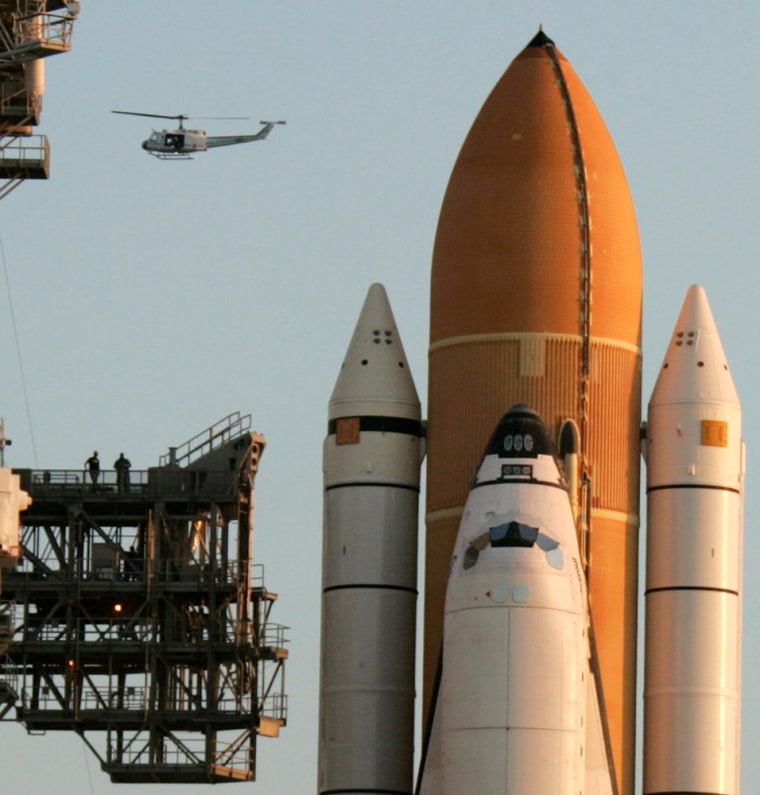The space shuttle Endeavour rolled out to a Florida launching pad early Friday to serve as a rescue craft for its sister ship Atlantis in what is expected to be the last time in history that NASA has two orbiters in launch position at the same time.
Riding atop NASA's Apollo-era crawler carrier vehicle, Endeavour completed the 4.2-mile (5.6-kilometer) trek to the seaside Launch Complex 39B at the Kennedy Space Center in Florida, at about 7 a.m. ET after a nearly eight-hour journey from the massive Vehicle Assembly Building. The shuttle Atlantis, meanwhile, stood nearby on Launch Complex 39A for its planned Oct. 10 launch toward the Hubble Space Telescope.
"This is the last time that this is ever going to happen," NASA spokesperson Allard Beutel told Space.com from the Florida spaceport.
NASA is preparing to launch seven astronauts aboard Atlantis next month on the final service call to the Hubble Space Telescope, where the spacefliers plan to perform five back-to-back spacewalks to install new cameras, replace aging batteries, gyroscopes and other components, add a docking ring and make tricky repairs to equipment never designed for in-flight maintenance.
A container packed with the spare parts and new instruments for Hubble will be delivered to Atlantis atop its launch pad late Saturday after a slight delay so engineers could clean up contamination in one of the cargo elements. The orbital overhaul is expected to extend the 18-year-old Hubble's mission through at least 2013.
But unlike recent missions to the international space station, where shuttle crews had the option of awaiting rescue aboard the outpost if their spacecraft suffered critical heat shield damage, Atlantis astronauts have no such safety net because they must fly higher and in a different orbit than the station to reach Hubble.
Instead, NASA plans to have Endeavour and a skeleton crew of four astronauts standing by in the unlikely event that Atlantis' heat shield is damaged beyond repair and the orbiter is unable to return to Earth. Under that plan, Endeavour would rendezvous with Atlantis and astronauts would stage a series of three spacewalks to retrieve the Hubble astronauts before discarding the stricken spacecraft.
"They would come up and they'd rendezvous with us," Atlantis shuttle pilot Gregory C. Johnson explained in a NASA interview. "We would grapple each other, robotic arm to robotic arm, essentially, and then would transfer crew members between the shuttles."
NASA mission managers and Atlantis astronauts consider the rescue plan an extremely unlikely scenario and are confident their mission will go as planned. Once Atlantis and its crew return safely to Earth, NASA will move Endeavour from Pad 39B to 39A for its planned Nov. 12 launch to haul fresh supplies and equipment to the spae station.
Pad 39B, meanwhile, is due to be turned over to NASA's Constellation program to be modified to launch the agency's new Ares 1 rockets. The launch vehicle is being designed to loft the agency's Orion shuttle successor into orbit by 2014 and on to the moon by 2020. The first Ares 1 test flight is set for June 2009.
"So it will no longer be a space shuttle launch pad. It will become an Ares rocket launch pad for NASA's next-generation spacecraft," Beutel said.
Meanwhile, NASA is enjoying a shuttle flight rarity with both Endeavour and Atlantis atop their respective launch pads. Two shuttles have stood simultaneously atop the two launch pads just 17 times before in the NASA's 27-year orbiter history, the last time in 2001 during the STS-105 and STS-104 missions. Atlantis' October launch will mark NASA's 124th space shuttle flight.
"People around here are proud of the shuttles and the work they've done on them, so they're looking forward to seeing two of them prominently displayed on the launch pad for everyone to see," Beutel said. "Knowing this will be the last time makes it a little extra special."
